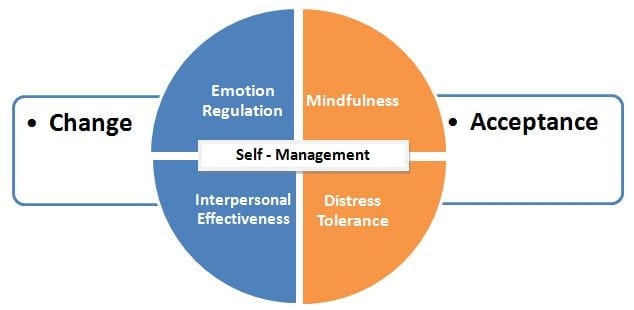Dialectical Behavior Therapy (DBT) was originally designed to treat individuals diagnosed as having Borderline Personality Disorder (which I was), but has skills and tools for everyone. DBT has been, notably, successful in individuals with Bipolar Disorder and PTSD as well. I have /have had all three diagnoses, so I started trying to find DBT therapy for myself about 2 years ago, when I first heard of it. Initially it wasnt covered by insurance and was rather expensive, so I stuck with Cognitive Behavioral Therapy (CBT) and got what I could get out of it.
CBT taught me to challenge my stinking thinking. I discovered that I tended to believe things that depended heavily on my belief that I could read people (the mind-reading fallacy). There was also my all or nothing thinking, discounting the positives, personalization, etc. (See this article for more information on this piece of CBT). The bottom line to my time in CBT was that I learned to challenge the way lifes circumstances had programmed me to think. I wasnt the lonely little Liz anymore who had to be hypervigilant and always prepare for the worst. Moreover, preparing for the worst was making me sick: my anxiety levels were through the roof and my anxiety made it that much easier to pick up substances.
About 8 weeks ago one of my favorite addiction counselors, Lauren, went to DBT Training along with another staff member at the behavioral health clinic I attend addiction/mental health recovery at. Lauren knew of my interest in DBT and invited me to join their group. Im not sure exactly what I expected, but the classroom-style teaching that went on was exactly what I needed. For once, I wasnt sitting and talking exclusively about my problems and having to extract the tools for recovery from my therapists. There was a plan. There were concrete tools for being mindful (aka aware), for regulating my emotions, for being effective in my interpersonal relationships and for tolerating distress in my life.
Below is a map to DBTbased on my experience and supplemented with resources, so that you can explore if this Zen-styled therapy might be helpful to you.
The Therapy Experience
Group is made up of a mindfulness exercise (usually meditation), review of homework (of which there is plenty), assignment of new homework and exploration of one of the 4 tenants to DBT: Mindfulness, Distress Tolerance, Interpersonal Effectiveness or Regulating Emotions.
Individual therapy (I go bi-weekly) explores how you are putting the tools to work, reviews your diary card (which is a daily log of your behaviors and emotions as well as the tools you have utilized) and helps you delve into whatever issues have come up that week/month.
The History
Dialectical behavior therapy (DBT) is a specific type of cognitive-behavioral psychotherapy developed in the late 1980s by psychologist Marsha M. Linehan to help better treat borderline personality disorder. Since its development, it has also been used for the treatment of other kinds of mental health disorders. See more here.
The Tenents
1) Mindfulness: the intentional, accepting and non-judgmental focus of one’s attention on the emotions, thoughts and sensations occurring in the present moment, which can be trained by meditational practices that are described in detail in the Buddhist tradition. See more here.
Examples of mindfulness that I employ are written meditations, guided meditations and consumption meditations. Written meditations are affirming words that I write to myself every day, with the intention of reprogramming my thinking and validating myself. A brief example is I am worthy of love I am making a healthier me I am on a spiritual journey to become the best person I can be. See more here, here, and here.
Guided meditations tend to be more popular. They are typically a man or woman speaking softly and rhythmically and directing you to think about certain things and/or relax certain parts of the body. There is a wealth of such meditations on the internet (and they rock!). See more here, here, and here.
Consumption meditations can be written or spoken or simply practicedwithout writing or describing formally. Two of my favorites are writing about my desire to be healthy physically and simply focusing on my sensory experiences when I am eating. Noticing texture on my tongue, taste, sound, sight focusing completely on what I am consuming.
2) Interpersonal Effectiveness is geared at helping me be assertive as well as being fair. Secondly it exists to ensure that Im not being aggressive or passive aggressive. Some tools of Interpersonal Effectiveness are:
DEARMAN is a method to settle conflicts.
- D escribe the situation mindfully and gently, using I feel not you make me feel statements.
- E xpress yourself without being judgmental of you or the other person.
- A ssert yourself kindly.
- R einforce your goals for the conversation.
- M indful of their ideals and yours.
- A ppear confident.
- N egotiate a plan to resolve the conflict.
- See more here.
GIVE (Gentle, Interested, Validate and Easy manner) is meant for close personal relationships and validates the other person. See more here.
3) Distress Tolerance is aimed at minimizing your stress and maximizing your happiness. I am only just learning this module. See more here.
4) Emotional (self-)regulation or regulation of emotion is the ability to respond to the ongoing demands of experience with the range of emotions in a manner that is socially tolerable and sufficiently flexible to permit spontaneous reactions as well as the ability to delay spontaneous reactions as needed. See more here, here, and here.
DBT has helped me eliminate ulcer symptoms, manage my anxiety and discontinue outbursts of insecurity and anger. I recommend reading more!
Read the rest of Liz’s posts here.


